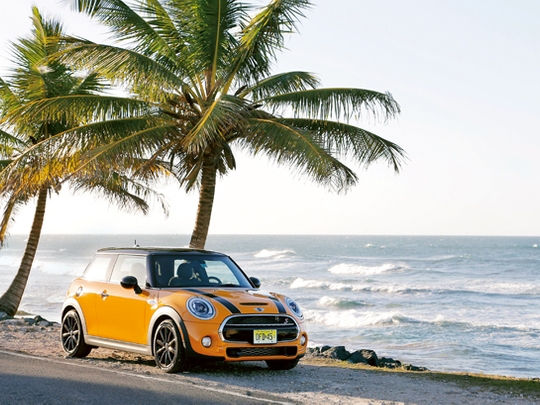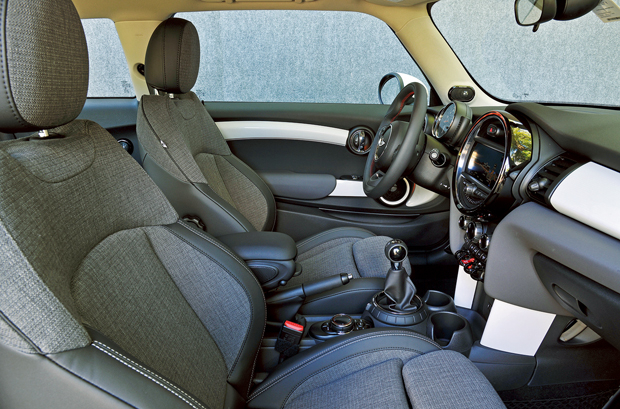
The new Mini is bigger because people want bigger Minis. Yes, there are focus groups, and plenty of participants shout, “I want a smaller Mini!” But the very next question from the manufacturer is, “OK, would you pay for it?”
Hushed murmurs. The answer is always “No”.
If Mini was to build a mini Mini – for example, the 2011 Rocketman Geneva show star, a full foot shorter than the hatchback – the car would require an entirely new structure, about as much investment as the rest of the range combined, and yet in Europe it would have to come in at well under €18,000 (around Dh90,000). A cheap Mini simply doesn’t fit in with the company’s overpriced image.
Instead of all that malarkey you get a bigger new Mini, albeit one that’s still the smallest car in class. “What class is that exactly?” I quizzed the brand’s various global bosses at the launch in Puerto Rico. “Well, actually here at Mini we don’t really feel we have any rivals.” So there you have it: the all-new Mini Cooper is the smallest car in a class of one.
Of course you could argue, quite effectively, that there are plenty of rivals out there, especially overseas, such as the Citroën DS3, stuff from Abarth, Renaultsport’s Clio and more, but since they’re all significantly cheaper than the Cooper, the guys sort of have a point.
This time though, I can’t really moan. It’s just a better bigger small car than anything else available. And the drive in Puerto Rico suits it immensely; I can’t tell whether the colourful island gels around our Volcanic Orange Cooper S, or whether the car is just one of the locals.
Over here Fiat 500s seem to dominate. The US is Mini’s biggest market but nobody told that to the ‘51st’ state. In Europe customers traditionally favour the manual to the tune of 60:40, but elsewhere the split reverses in favour of the automatic. We’re in an automatic for the first two-hour haul. Distances around here aren’t that great – the entire island is roughly a 150km by 50km rectangle – but the time it takes to traverse them is. Buses and pick-up trucks labour through the jungles, and chickens don’t care why they cross the road. Stray dogs chase the car and sometimes wins.
So the new Mini is bigger, but the most important thing is it still feels small. Sure enough you’re using your own little lane in the road (and they’re all little in Puerto Rico) and yet you discover there’s so much of it left unutilised, and that’s how the Mini can be fun at perfectly semi-legal speeds – the driving line is what you make it. That corner might be a long textbook left, but hang on; a chicken just got sick in a chicane. Puerto Rico in a Cooper S is fun… In that sense, not much has changed.
Yet of course it has, because this car is all new. It’s longer, wider and taller with a larger track both front and rear. As soon as you approach it you can tell. The engines are new, as well as the completely redesigned suspension and for the first time in a Mini, Dynamic Damper Control.
The interior, however, grabs you first. It’s vastly improved, with better fit and materials and nicely padded dash tops, and even the clumsy, cheap old toggle switches are now more taut and feel like actual steel toggles.
Thankfully the speedo has moved to its rightful position and the round central display is now reserved for infotainment (including Mini’s awesome Connected in-car entertainment system with satellite radio – it works in our region).
One of the main priorities in development was to lower weight, and it’s quite commendable that this noticeably larger car weighs either less or the same as before, depending on equipment.
That increased track should equal great dynamics, and the engineers gathered in Puerto Rico kept reminding us to try the new Mini Driving Modes via a rotary switch behind the gear lever.
Slot it into Sport and the entire round dial on the dash lights up red, variably darkening in relation to the mood of your right foot. On the move immediately, the most apparent improvement comes from the stiffer body structure and longer wheelbase – it just does not ride like a scrawny little car.
Over rough surfaces both the Cooper and Cooper S feel, honestly, like a BMW 1 Series or even an older 3 Series, just perfectly solid and weighted on the road and insusceptible to tramlining or following surface imperfections like small cars seem to do. Some of them get completely lost down heavily cambered roads or disappear in potholes – the Mini muscularly bullies through; must be those Dynamic Dampers.
One thing that doesn’t feel small, and isn’t, in the Cooper S is the engine. The Cooper S doesn’t have a small engine. In fact it has a massive one – 2.0 litres (previously it was 1.6) in a Mini even sounds wrong. Now it’s way more flexible, quicker but smoother, and as such it has lost that nervous, edgy fervour that made the old car a bit of a Jack Russell. It’s still a Jack Russell, mind you, it’s just no longer a puppy…
A 2.0-litre is a big engine. You can get a Jag XJ with a 2.0-litre. I think you can get a 7 Series with a 2.0-litre. This one in the Cooper S is turbo-charged to make a carefree 192bhp, which is 11 more than before.
It’s got direct injection and the lot, and it’ll get it to 100kph in less than seven seconds. But honestly, it was a bit lost on me, especially paired with an automatic that makes this Cooper S a bit more “all growed up” than a Mini has any right to be.
I asked the Mini guys about the new rear-engined, rear-drive Renault Twingo (that’s what this segment needs, something truly fresh) and they were quietly impressed. But for Mini to come in with a significantly smaller car and compete with the Twingo, for example, at around €18,000 is crazy. The hottest hypothetical Twingo RS will likely retail in Europe for €16,000. There simply is no such thing as image-conscious premiumness (yeah, I hate that word too) packaged small. Just ask the Cygnet.
And that gets me on to the truly mini Mini in the new Mini range. And it comes with a psychological factor…A three-cylinder engine is small. The Cooper gets that one, and it’s a 1.5-litre turbo doing 136bhp and it’s only one second slower to 100kph from rest than the Cooper S. That’s nothing. It’s a small engine in a small car. That’s how it’s supposed to be.
Alec Issigonis didn’t set out to create an icon. He wanted an affordable, practical, very clever little car, and it looked the way it did because that’s how it ended up. And its concept, the idea of a brilliant little never-before car, is what made it an icon.
BMW’s Mini is very concerned with image, very fretful about how everything must look ‘Mini’. There is no such thing. It must simply look like a great concept, it must look clever, and cultural symbolism will follow in due time.
The original Mini was honest, and that’s what we all loved. The new three-cylinder Cooper is honest too. And it has such great steering.
The Cooper S is like a suit that throws on a fedora and purple socks at night. Tomorrow morning, though, he’s still a suit, in a boardroom full of other grey suits and a pie chart on Powerpoint.
The three-cylinder Mini, on the other hand, ferries its owner to a co-op bakery specialising in gluten-free cupcakes. They’ve got a community wall with adverts for second-hand bicycles and harmonica players looking for band mates.
A Cooper S just runs that chicken over. A Cooper stops and chats, maybe plays a little tag with the dog.
Alex Flynn: The 10 million metre man
Suresh Menon: It’s time to cut the clichés
Should you lie to get your dream job?
Delhi gang rape victim’s friend ‘tortured by guilt’
Saving Shatila












